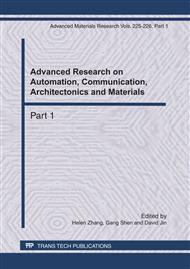[1]
H. Buxton. Learning and understanding dynamic scene activity: a review. Image and Vision Computing, 21(1): 125-136, (2003).
DOI: 10.1016/s0262-8856(02)00127-0
Google Scholar
[2]
G. Lu, X. Li, H. Li. Research on Recognition for Facial Expression of Pain in Neonates. ACTA Optica Sinica, 28(11): 2109-2114, (2008).
DOI: 10.3788/aos20082811.2109
Google Scholar
[3]
P. Ekman, W.V. Friesen. Facial Action Coding System (FACS). Consulting Psychologist Press, Inc. (1978).
Google Scholar
[4]
M. Grimm, D. Dastidar, K. Kroschel. Recognizing Emotion in Spontaneous Facial Expressions. International Conference on Intelligent Systems and Computing, (2006).
Google Scholar
[5]
W. Liu, Z. Wang. Facial Expression Recognition Based on Fusion of Multiple Gabor Features. The 18th International Conference on Pattern Recognition, (2006).
DOI: 10.1109/icpr.2006.538
Google Scholar
[6]
G. Littlewort, M. Bartlett, I. Fasel, et. al. Towards social robots: Automatic evaluation of human-robot interaction by face detection and expression classification. Neural Information Processing System, (2003).
Google Scholar
[7]
B. Lee, J. Chun, P. Park. Classification of Facial Expression Using SVM for Emotion Care Service System. The 9th ACIS International Conference on Software Engineering, Artificial Intelligence, Networking, and Parallel/Distributed Computing. (2008).
DOI: 10.1109/snpd.2008.60
Google Scholar
[8]
I. Kotsia, N. Nikolaidis, I. Pitas. Facial Expression Recognition in Video Using a Novel Multi-class Support Vector Machines Variant. ICASSP (2007).
DOI: 10.1109/icassp.2007.366303
Google Scholar
[9]
P. Belhumeur, J. Hespanha,D. Kriegman. Eigenfaces vs. Fisherfaces: Recognition using class specific linear projection. IEEE Trans. Pattern Anal. Mach. Intell, 19(7): 711-720, (1997).
DOI: 10.1109/34.598228
Google Scholar
[10]
H. Deng, J. Zhu,M. Lyu, I, King. Two-stage Multi-class AdaBoost for Facial Expression Recognition. Proceedings of International Joint Conference on Neural Network, (2007).
DOI: 10.1109/ijcnn.2007.4371439
Google Scholar
[11]
Y. Zhu,C. Silva, C. Ko. Using moment invariants and hmm in facial expression recognition. Pattern Recognition Letters, 23(1-3): 83-91, (2002).
DOI: 10.1016/s0167-8655(01)00108-8
Google Scholar
[12]
X. Mao,Y. Xue,Z. Li,K. Huang,S. Lv. Robust Facial Expression Recognition Based on RPCA and AdaBoost. WIAMIS (2009).
DOI: 10.1109/wiamis.2009.5031445
Google Scholar
[13]
Z. Ying, X. Fang. Combining LBP and Adaboost for Facial Expression Recognition. ICSP (2008).
Google Scholar
[14]
S. Jung,D. Kim, K, An, M, Chung. Efficient Rectangle Feature Extraction for Real-time Facial Expression Recognition based on AdaBoost. International Conference on Intelligent Robots and Systems, (2005).
DOI: 10.1109/iros.2005.1545534
Google Scholar
[15]
Imed Bouchrika. Gait Analysis and Recognition for Automated Visual Surveillance. School of Electronics and Computer Science, University of Southampton, (2008).
Google Scholar
[16]
S. Lajevardi, M. Lech. Facial Expression Recognition from Image Sequences Using Optimized Feature Selection.
DOI: 10.1109/ivcnz.2008.4762113
Google Scholar
[17]
P. Rani, N. Sarkar,J. Adams. Anxiety-based affective communication for implicit human machine interaction. Advanced Engineering Informatics. 21(2007): 323-334.
DOI: 10.1016/j.aei.2006.11.009
Google Scholar
[18]
H. Kage,M. Seki,K. Sumi,K. Tanaka,K. Kyuma. Pattern Recognition for Video Surveillance and Physical Security. SICE Annual Conference (2007).
DOI: 10.1109/sice.2007.4421282
Google Scholar
[19]
C. Huang, C. Wang. A GA-based feature selection and parameters optimization for support vector machines. Expert System with Applications, 31(2006): 231: 240.
DOI: 10.1016/j.eswa.2005.09.024
Google Scholar
[20]
L. Tang, Y. Zhou,J. Jiang, et. al. Radius Basis Function Network-Based Transform for a Nonlinear Support Vector Machine as Optimized by a Particle Swarm Optimization Algorithm with Application to QSAR Studies. J. Chen. Inf. Model, 47(2007).
DOI: 10.1021/ci700047x.s001
Google Scholar
[21]
F. Melgani,Y. Bazi. Classification of Electrocardiogram Signals with Support Vector Machines and Particle Swarm Optimization. IEEE Trans. On Information and Technology in Biomedicine, 12(5): 667-677, (2008).
DOI: 10.1109/titb.2008.923147
Google Scholar
[22]
Z. Liu,C. Wang,S. Yi. A combination of modified particle swarm optimization algorithm and support vector machine for Pattern Recognition. The 3rd International Symposium on Intelligent Information Technology Application, (2009).
DOI: 10.1109/iita.2009.149
Google Scholar
[23]
S. Romdhani, P. Torr, B. Acholkopf,A. Blake. Efficient face detection by a cascaded support vector machine expansion. Proceedings of the Royal Society, (2004).
DOI: 10.1098/rspa.2004.1333
Google Scholar
[24]
Russel Eberhart, James Kennedy. A new optimizer using particle swarm theory. The sixth international symposium on micro machine and human science, 1995: 39-43.
DOI: 10.1109/mhs.1995.494215
Google Scholar
[25]
Yuhui Shi, R C Eberhart. Proceedings of IEEE International Conference on Evolutionary Computation, 1998, 69-73.
Google Scholar


